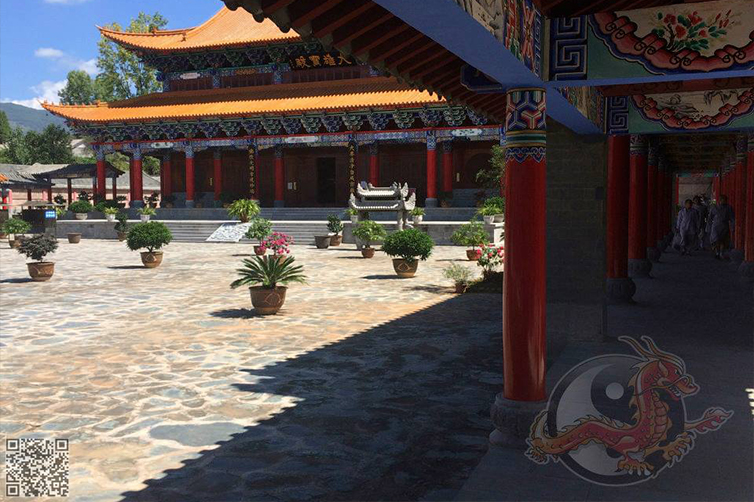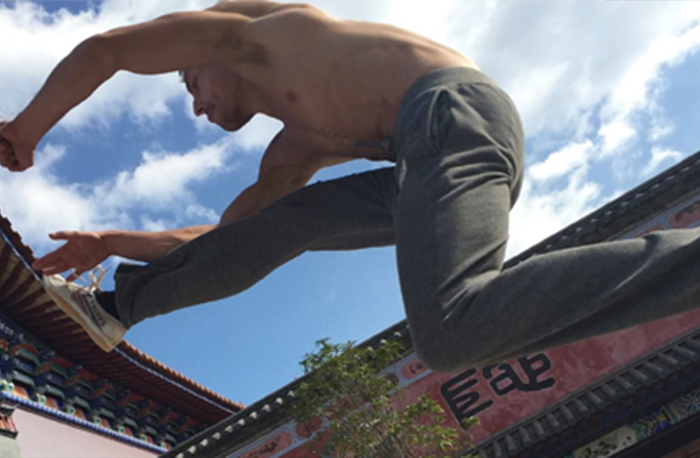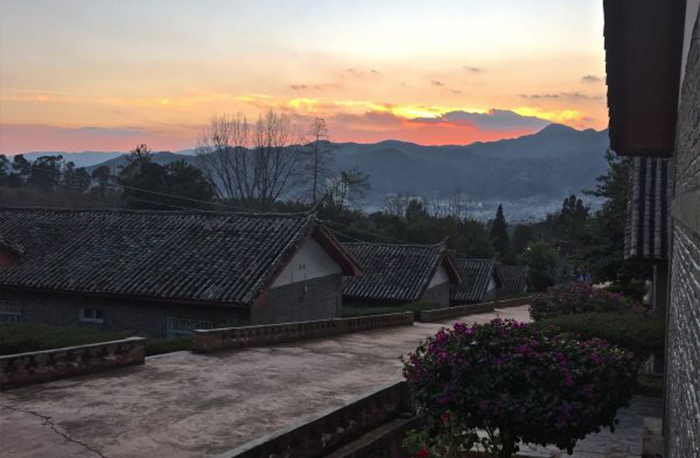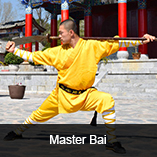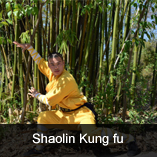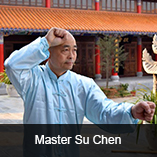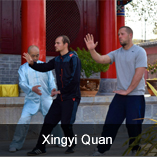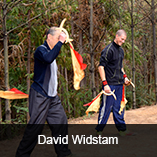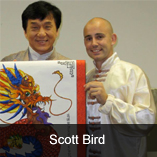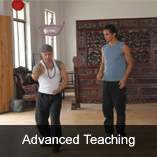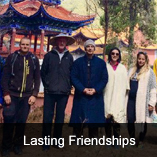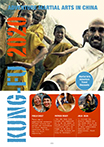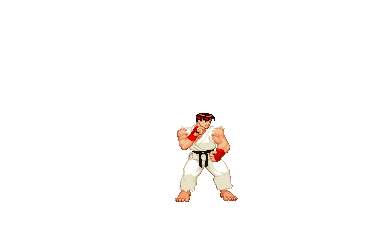Baguàzhang is one of the major "internal" Chinese martial arts. Baguà zhang literally means "eight trigram palm," referring to the trigrams of the I Ching (Yijing), one of the canons of Taoism.
The creation of Baguazhang, as a formalized martial art, is attributed to Dong Haichuan in the early 19th century. He is said to have created it from what he had learned from Taoist, and possibly Buddhist, masters in the mountains of rural China. Evidence suggests Baguazhang is a synthesis of several pre-existing martial arts of rural China combined with Taoist circle walking.
Baguazhang styles include: Yin Style, Shi Style, Cheng Style, Liu Style, Liang Style, Fu Style, Gao Style, Gong Style, Jiang Style and Yin Yang Style. All these styles share the practice of circle walking, or "Turning the Circle". For a beginner traditional training meant walking a circle six to twelve feet in diameter. Practitioners walk around the edge of the circle in various low stances, facing the center, and periodically change direction as they execute forms. Students first learn flexibility and proper body alignment through such exercises, then move on to more complex forms and internal power mechanics. The internal aspects of Baguazhang are similar to, yet distinct from, those of Xingyi and Tai Chi.
Many distinctive styles of weapons are contained within Baguazhang, some use concealment like the "scholar's pen" or a pair of knives (the most elaborate, which are unique to the style, are the crescent-shaped deer horn knives). Baguazhang is also known for practicing with extremely large weapons, such as the B?guàjian or 'Bagua Sword' and B?guàd?o or 'Bagua Broadsword'. Other more conventional weapons are also used like the staff (gun), the spear (qiang), the crutch (guai), the hook sword (gou) and the straight (double-edged) sword. Baguazhang practitioners are also known for being able to use anything as a weapon using the principles of their art.
Baguazhang contains an extremely wide variety of techniques, including various strikes (with palm, fist, elbow, fingers etc), low kicks, joint locking techniques, throws, and distinctively evasive circular footwork. The Baguazhang practitioners are known for their ability to "flow" in and out of the way of objects. This is where the theory of being able to fight multiple attackers came into view.
Strict Baguazhang teaches that if you are to defeat more than one opponent you must first learn to quickly eliminate an opponent with fast and effective joint locks, knockouts, breaks, and other form of physical trauma. Under close examination, Baguazhang can be compared to a form of above ground wrestling. Many of wrestling's philosophies are very similar to Baguazhang's.
Tai chi chuan or Taijiquan is an internal Chinese martial art using hard and soft techniques and represents the fusion of Yin and Yang applied to the human body. Most modern styles of tai chi trace their development to at least one of five traditional schools: Chen Style, Yang Style, Wu/Hao Style, Wu and Sun Style.
Tai chi chuan is generally classified as a soft internal style and its study primarily involves three aspects health, meditation and martial art.
Health: An unhealthy or otherwise uncomfortable person may find it difficult to meditate to a state of calmness or to use tai chi as a martial art. Tai chi's health training therefore concentrates on relieving the physical effects of stress on the body and mind. For those focused on tai chi's martial application, good physical fitness is still an important step towards effective self-defense.
Meditation: The focus and calmness cultivated by the meditative aspect of tai chi is seen as necessary in maintaining optimum health (in the sense of relieving stress and maintaining homeostasis) and in application of the form as a soft style martial art.
Martial art: The ability to use tai chi as a form of self-defense in combat is the test of a student's understanding of the art. Tai chi chuan martially is the study of appropriate changes in response to outside forces; the study of yielding and "sticking" to an incoming attack rather than attempting to meet it with opposing force.
Sanda (Sanshou) or ‘Chinese kickboxing’ has spread and evolved into a Chinese national sport. Sanda is a Chinese hand to hand combat self defense system and combat sport. As a sport Sanda has strict rules to ensure the safety of the two fighters during bouts. The rules prohibit attacks to the back of the head, spine or groin and discontinue combat when a fighter falls to the ground. However, many schools whether traditional or modern, or that practice Sanda for competing or not, practice it as an all round martial arts systems with no restrictions, only adapting their training in relation to competition rules prior to the event. Teaching and practicing techniques to restrain, maim, injure or kill an opponent or opponents. Sanda tournaments are one of the two sport wushu disciplines recognized by the International Wushu Federation.
Sanda or Sanshou is a synthesis of a few traditional Chinese kung fu fighting techniques into a more amorphous system and is commonly taught alongside traditional Chinese styles which Sanshou techniques, theory and training methods are derived from. The emphasis of Sanshou is on realistic fighting ability.
As an unarmed self-defense, close combat system, Sanshou includes da (punches), ti (kicks), shuai (grappling), and na (throws, locks, chokes). Sanda as a sport emphasizes throws in terms of point scoring. One of its most distinguished techniques is the "kick catch". This is when one person kicks and the person performing the throw catches the kick and then trips the person kicking. While kickboxing styles, such as Muay Thai also allow this, the kick catch is emphasized in Sanshou because of the importance it is given by the judges.
Shaolin Boxing is the short form for 'Shaolin Temple Boxing Techniques'. As a means of spiritual discipline, Shaolin Boxing has been integrated in hundreds of schools, with Chan Buddhist influence or Zen guiding its presence. 'Shaolin boxing styles very greatly. There are in fact hundreds of different boxing styles. Students usually will practice general basics and then will devote him or herself to one or two boxing and weapon styles.
Shaolin Kung fu practice is generally talked about in terms of three realms.
1. In the primary realm, the practitioner practices their form and appearance.
2. In the intermediate realm, there is the integration of mind and fist, changing the tangible into the intangible, turning the law into the lawless; obeying no rules, having no movement to follow, controlling the enemy in the intangible. An ancient boxing manual reads, `defeat a person in the intangible or fail being seen`.
3. Shaolin Kungfu's highest realm is for all to be guided by the heart and to fight not just from form but from the formless.
Shaolin Buddhist practice is started in the mindful training of Kung Fu as it cultivates greater awareness. The purpose of learning Kung Fu no longer becomes the goal in itself, but is used as a means of awakening.
Features of Shaolin Kung Fu
1. Short but precise.
2. Box in a line.
3. Casual footwork.
4. Roll in and out.
5. Integration of mind and behavior.
6. Bending but actually not and straight but actually not.
7. Rise high in a tight form and drop in a spreading way. Rise to move with an intention of advance and drop to move with an intention of retreat.
8. Integration of Buddhism and boxing.
9. Focus on defense.
10. Combination of attacking and defending.
11. Numerous tricks.
12. Simple and practical.
13. Vigorous and strong.
14. Numerous acts shrinking back.
15. Numerous kicks.
16. Produce sounds.
Baji Quan, is a traditional Chinese Marital Arts that features explosive, short range power. It originated in Hebei Province in Northern China, but is also well-known in other places today, especially Taiwan. Also known as "rake fist" due to the fist being held loosely and slightly open when not striking, resembling a rake. The term baji signifies “an extension in all directions" and in this case, it means “including everything" or “the universe." 'Ba' (Chinese for eight) denotes the eight major points of the body: head, shoulders, elbows, hands, buttocks, kua, knees, and feet and 'Ji' (polar) is extended in the eight polar directions. Bajiquan shares roots with another Hebei martial art, Piguazhang. It is said that Wu Zhong, the oldest traceable lineage holder in the Bajiquan lineage, taught both arts together as an integrated fighting system. They split apart, only to be recombined by Li Shuwen in the late 18th to early 19th century. As a testament to the complementary nature of these two styles, there is a Chinese martial arts proverb that goes: "When pigua is added to baji, gods and demons will all be terrified. When baji is added to pigua, heroes will sigh knowing they are no match against it." Bajiquan is characterized by direct, culminating and powerful fast strikes that will render an opponent unable to continue and is used in close combat, giving attention to elbow, knee, shoulder and hip strikes. When blocking an attack or nearing an opponent, Bajiquan techniques emphasize striking major points of vulnerability, the thorax (trunk of the body), the legs and neck. The major purpose of Ba Ji training is to develop ultimate snapping power with each strike and open the opponent's arms forcibly (Qiang Kai Men) and mount attacks at high, mid, and low levels of the body, or San Pan Lian Ji.
Six Major Characteristic Powers:
1. Sinking (Xia Chen or Chen Zhui)
2. Thrusting (Chong)
3. Extending (Cheng)
4. Entangling (Chan)
5. Crossing (Shi Zi)
6. Explosive and short (Cun)
The six big ways of opening the door or Liu Da Kai: is the most important practice of Baji
1. Ding: using the fist, elbow or shoulder to push forward and upward.
2. Bao: putting arms together as if hugging someone. It is usually followed by chop (Pi).
3. Ti: elevating the knee to hit the thigh of the opponent, or elevating the foot to hit the shin of the opponent etc.
4. Dan: using a single move.
5. Kua: using the hip.
6. Chan: entanglement with rotation around the wrist, elbow and shoulder
Stepping and Body Methods:
Footwork in Baji Quan has three special features: Zhen Jiao, Nian Bu and Chuang Bu. These striking techniques relate to ancient Chinese medicine, which states that all parts of the body are connected, either physically or spiritually.
Open Hand Forms and Weapons:
The forms of Baji are divided into Fist (non-weapon) and Weapon forms. There are 20 fist forms, which include 12 Baji Small Structure Fists, Baji Black Tiger Fist, Baji Dan Zhai, Baji Dan Da/Dui Da, Baji Luo Han Gong, and Baji Si Lang Kuan. There are eight weapons forms, including Liu He Da Qiang (spear), Liu He Hua Qiang (spear), Chun Yang Jian (sword), San Yin Dao (sabre), Xing Zhe Bang (staff), Pudao, and Chun Qiu Da Dao (a long two-handed heavy blade, used by Generals sitting on their horses).
Some of Baji's forms:
Black Tiger Fist, Small Frame 4th Road, Single Plucking, Small Frame 5th Road, Small Frame 3rd Road, Small Frame 6th Road, LoHan (Buddha's Disciple) Work, Small Frame 1st Road, Small Frame 2nd Road, Six Big Openings- Liu Da Kai, Pu Dao Plain Knife, Spring Autumn Big Knife, 6 Harmony Big Spear, Single Strike, Railing Hand Partner Set- Fu Shou, Si Lang Kuan, Pure Yang Sword, Raise the Willow Saber, Travelling Staff, Six Harmony Spear.
Qigong, qi gong, chi kung, or chi gung (simplified Chinese: 气功; traditional Chinese: 氣功; pinyin: qìgōng; Wade–Giles: chi gong; literally: "Life Energy Cultivation") is a holistic system of coordinated body posture and movement, breathing, and meditation used for health, spirituality, and martial arts training. With roots in Chinese medicine, philosophy, and martial arts, qigong is traditionally viewed as a practice to cultivate and balance qi (chi) or what has been translated as "life energy".[1]
According to Daoist, Buddhist, and Confucian philosophy, respectively, qigong allows access to higher realms of awareness, awakens one's "true nature", and helps develop human potential.[2]
Qigong practice typically involves moving meditation, coordinating slow flowing movement, deep rhythmic breathing, and calm meditative state of mind. Qigong is now practiced throughout China and worldwide for recreation, exercise and relaxation, preventive medicine and self-healing, alternative medicine, meditation and self-cultivation, and training for martial arts.
Qigong, qi gong, chi kung, or chi gung (simplified Chinese: 气功; traditional Chinese: 氣功; pinyin: qìgōng; Wade–Giles: chi gong; literally: "Life Energy Cultivation") is a holistic system of coordinated body posture and movement, breathing, and meditation used for health, spirituality, and martial arts training. With roots in Chinese medicine, philosophy, and martial arts, qigong is traditionally viewed as a practice to cultivate and balance qi (chi) or what has been translated as "life energy".[1]
According to Daoist, Buddhist, and Confucian philosophy, respectively, qigong allows access to higher realms of awareness, awakens one's "true nature", and helps develop human potential.[2]
Qigong practice typically involves moving meditation, coordinating slow flowing movement, deep rhythmic breathing, and calm meditative state of mind. Qigong is now practiced throughout China and worldwide for recreation, exercise and relaxation, preventive medicine and self-healing, alternative medicine, meditation and self-cultivation, and training for martial arts.
https://en.wikipedia.org/wiki/Qigong
Wushu as a sport is both an exhibition and a full-contact sport derived from traditional Chinese martial arts. Created in the People's Republic of China after 1949, Wushu has spread globally through the International Wushu Federation (IWUF), which holds the World Wushu Championships every two years.
Wushu is composed of two disciplines: taolu (forms) and sanda (sparring). The forms are similar to gymnastics and involve martial art patterns and maneuvers for which competitors are judged and given points according to specific rules. The forms comprise basic movements, stances; kicks, punches, balances, jumps, sweeps and throws based on the aggregate categories traditional Chinese martial art styles and can be changed for competitions to highlight one's strengths. Competitive forms have time limits that can range from 1 minute, 20 seconds for external styles to over five minutes for internal styles.
Wushu Events:
• Bare handed: Changquan (Long Fist), Nanquan (Southern Fist) and Taijiquan (Taiji Fist)
• Short Weapons: Dao (Single edged sword), Jian (Double edged sword), Taijijian (Taiji double edged sword) & Nandao (Souther single edged sword)
• Long Weapons: Gun (Staff), Qiang (Spear) and Nangun (Southern Staff)
• Sanda: Sparring/Free Fighting
Most of the events were set up in 1958.
These events are performed using compulsory or individual routines in competition. Compulsory routines are those routines that have been already created for the athlete, resulting in each athlete performing basically the same set. Individual routines are routines that an athlete creates with the aid of his/her coach, while following certain rules for difficulty, number of acrobatics, etc.
The Sun-style (孫氏) t'ai chi ch'uan is well known for its smooth, flowing movements which omit the more physically vigorous crouching, leaping and fa jin of some other styles. The footwork of Sun style is unique, when one foot advances or retreats the other follows. It also exhibits small circular movements with the hand. Its gentle postures and high stances make it very suitable for martial arts therapy.
Sun style t'ai chi ch'uan was developed by Sun Lutang, who was considered expert in two other internal martial arts styles: xingyiquan and baguazhang before he came to study t'ai chi ch'uan. Today, Sun-style ranks fourth in popularity and fifth in terms of seniority among the five family styles of t'ai chi ch'uan. He was also considered an accomplished Neo-Confucian and Taoist scholar, especially in the Yi Jing and the T'ai chi classics. Sun learned Wu (Hao)-style t'ai chi ch'uan from Hao Weizhen, who was Li Yiyu's (李亦畬) chief disciple.[1]
https://en.wikipedia.org/wiki/Sun-style_t%27ai_chi_ch%27uan Sun Style Baguazhang is derrived from Baguazhang from Cheng Tinghua (程延華) (from 1891).
https://en.wikipedia.org/wiki/Sun_Lu-t%27ang Sun Style Xingyi Quan is derived from the following: Xingyiquan from Li Kuiyuan (李魁元), and later from Guo Yunshen (郭雲深) (from 1882).
https://en.wikipedia.org/wiki/Sun_Lu-t%27ang Qinna or Chin na are seizing and controlling techniques. It is the term used to describe techniques which lock up an opponent. Literally Qinna means catching and locking in Chinese. Qinna techniques can be specialized in. However, they are more likely to be used as an essential part of combat. To that end Qinna is one of the four components of unarmed combat used in Chinese martial arts. These four components are: Kicking (Ti), Striking (Da), Wrestling (Shuai) and Seizing Control (Na).
While techniques along the lines of qinna (chin na) are trained to some degree by most martial arts worldwide, many Chinese martial arts are famous for their specialization in such applications. Styles such as Eagle Claw (Y?ng zhua quán ), which includes 108 different chin na techniques, Praying Mantis (Tánglángquán) the "Tiger Claw" techniques of Hung Gar, & Shuai Jiao are well known examples.
Qinna (Chin na) can generally be categorized as:
1. "Fen Jin" or "Zhua Jin" (dividing the muscle/tendon, grabbing the muscle/tendon). "Fen" means "to divide", "Zhua" is "to grab" and "Jin" means "tendon, muscle, sinew". They refer to techniques which tear apart an opponent's muscles or tendons.
2. "Cuo Gu" (misplacing the bone). "Cuo" means "wrong, disorder" and "Gu" means "bone". Cuo Gu therefore refer to techniques which put bones in wrong positions and is usually applied specifically to joints.
3. "Bi Qi" (sealing the breath). "Bi" means "to close, seal or shut" and "Qi", or more specifically "Kong Qi", meaning "air". "Bi Qi" is the technique of preventing the opponent from inhaling. This differs from mere strangulation in that it may be applied not only to the windpipe directly but also to muscles surrounding the lungs, supposedly to shock the system in to a contraction which impairs breathing.
4. "Dian Mai" or "Dian Xue" (sealing the vein/artery or acupressure cavity). Similar to the Cantonese "Dim Mak", these are the technique of sealing or striking blood vessels and "Qi" points.
Qin or Chin means to seize or trap, na means to lock or break, and while those actions are very often executed in that order (trap then lock), the two actions can also be performed distinctly in training and self defense.
There is quite a bit of overlap between Qinna (Chin na) theory and technique with the branches of traditional Chinese medicine known as Tui na as well as the use of offensive and defensive qigong as an adjunct of Qinna (Chin na) training in some styles. In fact traditional Chinese medicine has been an essential part of the martial arts in China for both healing injuries and understanding the body’s weaknesses and strengths.
As with most styles of Chinese martial arts the origins of Xingyi quan (hsing-i chuan, xing-i, or hsing yi) are shrouded in mystery. This ancient martial art is said to be the oldest of the internal Chinese martial arts and is said to elongate life expectancy and purify the morality of its practitioners, as well as greatly improving their self-defense capabilities.
The creation of the Art is traditionally attributed to the famous general and patriot Yue Fei (1103-1141) of the Sung Dynasty. Being a beloved historical figure and warrior, Yue Fei is credited with the creation of several systems of martial arts. There is, however, no historical evidence to support the claim that he had anything to do with the creation of the art Xing Yi Quan. The style was originally called Xin Yi Liu He Quan [Heart Mind Six Harmonies Boxing]. The Six harmonies refer to the Three Internal Harmonies (the heart or desire harmonizes with the intent; the intent harmonizes with the Qi or vital energy; the Qi harmonizes with the physical strength), and the Three External Harmonies (the shoulders harmonize [coordinate] with the hips; the elbows harmonize with the knees; the hands harmonize with the feet). The practitioner's internal processes harmonize and coordinate the external movement, unifying the person as a whole into the most powerful state possible.
Xingyi is a powerful and direct internal martial art. Xing Yi Quan is commonly referred to as Form and Mind or Form and Will boxing. The name illustrates the strong emphasis placed on the motion of the body being subordinate to conscious control. The form the body takes is an external manifestation of the internal state of mind and is the underlying premise behind Xing Yi Quan as a method of combat.
Xing Yi Quan is divided into two main systems: the Ten Animal and the Five Elements. The Five-Element system is further divided into two main branches, the He Bei and Shan Xi styles.
The Ten Animal style is closest to the original Xin Yi Liu He Quan in form and practice. The movements in the forms are patterned after the spirit of various animals in combat, including the Dragon, Tiger, Monkey, Horse, Chicken, Hawk, Snake, Bear, Eagle and Swallow.
The Five Element based systems have five basic forms: Splitting, Drilling, Crushing Pounding and Crossing; these Five Elements form the foundation of the Art. The basic energies of the Five Elements are then expanded into Twelve Animal forms which include variations of the animal forms found in the Ten Animal styles as well as two additional animals, the Tai (a mythical bird) and the Tuo (a type of water skimming insect). Training in all systems centers on repetitive practice of single movements that are later combined into more complicated linked forms.
The direction of movement in Xing Yi forms is predominately linear. Practitioners walk through the forms coordinating the motions of their entire bodies into one focused now. The hands, feet and torso all arrive together and the nose, lead hand and lead foot are aligned along the same vertical axis (San Jian Xiang Jiao). The arms are held in front of the body and the practitioner lines up his or her centerline with the opponent's centerline. A familiar adage of Xing Yi Quan is that "the hands do not leave the [area of] the heart and the elbows do not leave the ribs." There are few kicks in the style and the techniques are predominately percussive in nature. Great emphasis is 'placed upon the ability to generate power with the whole body and focus it into one pulse which is released in a sudden burst.
The techniques of Xing Yi Quan are characteristically aggressive in nature and the Xin Yi Quan fighter prefers to move into the opponent with a decisive strike at the earliest opportunity. The style prizes economy of motion and the concept of simultaneous attack and defense. As the name implies, the form or shape of the movements is only a physical manifestation of one's internal state [intent]. A fundamental principle underlying all styles of Xing Yi Quan is that the mind controls and leads the movements of the body.
Training in He Nan (Ten Animal) Xin Yi Liu He Quan includes basic movements designed to condition and develop the striking ability of the Seven Stars [the head, shoulders, elbows, hands, hips, knees and feet]. From here, the student will progress to learning the basic animal forms. Basic form practice consists of repeating single movements while walking forward in various straight-line patterns. Later, the single movements are combined into linked forms. The techniques are relatively simple and straightforward and rely on the ability to generate force with almost any part of the body (the Seven Stars). Also included at more advanced levels are weapons forms (including the straight sword, staff and spear).
The Five Element based styles of Xing Yi Quan (Shan Xi and He Bei styles) traditionally begin training with stance keeping, the holding of static postures for prolonged periods of time (Zhan Zhuang). The most fundamental posture is called San Ti(Three bodies)or San Cai (Three Powers referring to heaven, earth and man). It is from this posture that all of the subsequent movements in the style are created, and most teachers place great emphasis upon its practice. After stance training, the student begins to learn the Five Element Fists (Wu Xing Quan). These are the basic movements of the Art and express all the possible combinations of motion which produce martial power (including energy which moves downward upward, forward, outward and inward). After a certain level of proficiency is acquired in the practice of the Five Element Fists, the student goes on to learn the twelve Animal and linked forms. The twelve Animal forms are variations of the energies of the Five Elements expressed through the format of the spirit of animals in combat. There are several two-person combat forms that teach the student the correct methods of attack and defense and the applications of the techniques practiced in the solo forms. Five Element based styles also include weapons training.
Xing Yi Quan is the oldest of the 'internal' martial arts, and the only internal art proven effective on the battlefield. Based on the movements of the spear, the strategies and techniques of Xing Yi Quan are designed to subdue an opponent in the shortest possible amount of time (as prolonged exchanges were not conducive to survival in mass battle situations). The basic fighting strategy of Xing Yi Quan dictates an aggressive "take no prisoners" attitude, with the goal of incapacitating an opponent as quickly as possible. There are no flashy or overly complicated techniques; the art is a study in practical efficiency. The fact that Xing Yi Quan fighters have been among the small percentage of the most elite for the past four hundred years in China lends credibility to the Art's efficacy in training, strategy and application.
In conclusion the aggressive nature of Xing Yi Quan can be summed up in the key words of the style: Brave, Fierce, Sudden, Wicked, Quick, Violent, First and Sharp. The study of its strategies and techniques provides a fascinating view of the mindset of the warriors of old. In the modern world, Xing Yi Quan training, besides conferring excellent health benefits, provides a practical, no-nonsense approach to cultivating the attitudes and physicality necessary for real fighting ability.
